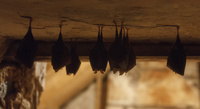Why it’s different for bats in Kerry
Learning about wildlife is ever evolving, including the lesser horseshoe bat in Ireland.

How is it that when you think you might understand a species and how they behave, they surprise you with doing something unexpected.
In this case we’re talking about the lesser horseshoe bat, the only species of horseshoe bat to occur in Ireland. More specifically we are sharing our observations of lesser horseshoe bats in Kerry and where they are found during the winter months in comparison with those found further north in Clare and Mayo— and what was once considered the norm.

Hibernating lesser horseshoe bat ©Daniel Hargreaves
In winter, Irish bat species lower their body temperature to that of the roost they occupy as a way of saving energy, which is necessary when the food they normally hunt is in short supply. In Ireland, lesser horseshoe bats in the northern part of their distribution hibernate in natural caves and underground sites. However, in Kerry there are fewer natural caves in the areas where horseshoe bats are found, so we find them hibernating in buildings, which is unusual! We suspect that the normally milder winters in the south of Ireland renders the unheated roosts suitable for hibernation. This phenomenon has been observed since the late 1970s when the National Parks and Wildlife Service (NPWS) began its winter monitoring of this species.
Kate McAney, Ireland Mammal Programme Manager, organised two extensive winter surveys of the lesser horseshoe bat in Ireland with assistance from NPWS staff and bat volunteers from Ireland and Britain in the 1990s and the results of these surveys were published in a special supplement of The Irish Naturalists Journal. All the winter monitoring of this species is now carried out by NPWS – except for those bats that choose to stay in VWT’s Kerry reserves!
Seven of the eight Kerry VWT bat reserves are checked during the winter months every year for hibernating bats because of the high numbers of bats using them. At one site in Kerry the numbers of bats present in summer and winter varies little, suggesting that this building is essential for providing refuge all year round. Although we regularly check our four northern reserves for storm damage during winter, we find only one or two lesser horseshoe bats use these.
So, what does this mean?
We have had to adjust our understanding and monitoring of the species — and in the history of managing these sites, we have had to adapt our approach to roost restoration.
When VWT began restoring buildings in Kerry for the benefit of lesser horseshoe bats, additional consideration was given to providing internal features that might be suitable for hibernating bats, based on information provided by NPWS that this species is found in buildings during winter.So, inside one building we created a ‘cool room’ in a section of a north-facing ground floor room by constructing a block wall from floor to ceiling, leaving just a small hatch as an access point for both humans and bats. This room held 249 hibernating horseshoe bats when checked last winter, which is approximately one third of the number that emerged during the previous summer.
Typically, building renovation work to benefit bats is carried out in the winter months when bats are not present. However, at another of our Kerry sites we had to renovate in summer, because due to the deterioration of the roof the bats were only using it in winter! Since the renovation work, the bats now spend the summer months under the new roof and need only to fly down a stairwell to the cool ground floor for hibernation. We counted 125 bats hibernating there this winter while 215 were recorded during the summer counts.

Lesser horseshoe bat in flight ©Daniel Hargreaves
Would these bats use our buildings if there were ‘natural’ hibernation spaces such as underground caves? We can only speculate but what is clear is that we need to keeplearning and adjusting our approach to conserving this species.
Kate McAney, VWT's Ireland Mammal Programme Manager
